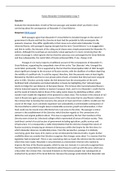Essay
A* Russia and its Rulers Alexander II Interpretation Exemplar Essay
- Course
- Institution
- Book
Evaluate the interpretations in both of the two passages and explain which you think is more convincing about the consequences of Alexander II's Great Reforms. An A*-graded response to the 2018 OCR interpretation question on Alexander II.
[Show more]




